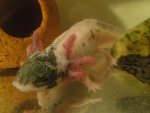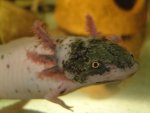Morrison
Active member
- Joined
- Jul 17, 2010
- Messages
- 1,625
- Reaction score
- 16
*Edit* I mean 'increased'...
Has anyone else experienced this?
My leucistic female Frangipane (2) never really had any pigmentation. She just had some little freckles on her face.
Last year it got pretty hot in my room during the summer and it's pretty hard for me to keep the temperature down. I noticed that all my axies had a change in pigmentation.
My wildtypes had a little greyish coat on their faces. Not really the same like you usually see on heat stress, but more like it's pigmentation. My golden axie became more golden (on her face and her back) and the biggest change happened to Frangipane. She started to develop a black 'mask' on her face during the summer. (I added some before and after pics below). After a while I also noticed some 'pigmentation' on her side and tail.
It never really disappeared. Maybe it got a bit less but I'm not sure.
This year, it's pretty hot! I just try to keep everything as cool as possible with icebottles and fans but today the water was about 24°C! So I added a lot more ice bottles and I guess it helped a bit.
But my friend came over a few days ago and he said: "Wow! Look at Frangipane! The blackness has spread. Looks like she's wearing a mask!" And I didn't really notice it, but it's even darker now.
She doesn't seem to bother it. She's not scratching or anything, just being a lotl, doing lotly things and think lotl stuff and eat lotly worms and pellets. But I was wondering if anything has experienced this too? Is it rare?
Is there a way to get her back to normal? It looks like a highly pigmentated leucistic, but not as pretty as the 'normally pigmentated ones' but it somehow look a bit like it's caked on her face at some places. Like it's a little layer of moss on a tree.
What exactly is it? Who can help me out? (I can't do fridging, as it killed 2 of my axies before. I don't know why but I don't trust it in there).
* Another thing (the last picture). I also noticed a strange dark spot on the chest of my awesome Spotl. It's kinda freaky... Help.
Pictures, lalala:
Pic 1: Frangipane before the 'madness'
Pic 2: Last year
Pic 3 and pic 4: What it looks like right now. Pic 4 is about the same angle as pic 2, to show the difference.
Pic 5: Spotl's weird spot...
Has anyone else experienced this?
My leucistic female Frangipane (2) never really had any pigmentation. She just had some little freckles on her face.
Last year it got pretty hot in my room during the summer and it's pretty hard for me to keep the temperature down. I noticed that all my axies had a change in pigmentation.
My wildtypes had a little greyish coat on their faces. Not really the same like you usually see on heat stress, but more like it's pigmentation. My golden axie became more golden (on her face and her back) and the biggest change happened to Frangipane. She started to develop a black 'mask' on her face during the summer. (I added some before and after pics below). After a while I also noticed some 'pigmentation' on her side and tail.
It never really disappeared. Maybe it got a bit less but I'm not sure.
This year, it's pretty hot! I just try to keep everything as cool as possible with icebottles and fans but today the water was about 24°C! So I added a lot more ice bottles and I guess it helped a bit.
But my friend came over a few days ago and he said: "Wow! Look at Frangipane! The blackness has spread. Looks like she's wearing a mask!" And I didn't really notice it, but it's even darker now.
She doesn't seem to bother it. She's not scratching or anything, just being a lotl, doing lotly things and think lotl stuff and eat lotly worms and pellets. But I was wondering if anything has experienced this too? Is it rare?
Is there a way to get her back to normal? It looks like a highly pigmentated leucistic, but not as pretty as the 'normally pigmentated ones' but it somehow look a bit like it's caked on her face at some places. Like it's a little layer of moss on a tree.
What exactly is it? Who can help me out? (I can't do fridging, as it killed 2 of my axies before. I don't know why but I don't trust it in there).
* Another thing (the last picture). I also noticed a strange dark spot on the chest of my awesome Spotl. It's kinda freaky... Help.
Pictures, lalala:
Pic 1: Frangipane before the 'madness'
Pic 2: Last year
Pic 3 and pic 4: What it looks like right now. Pic 4 is about the same angle as pic 2, to show the difference.
Pic 5: Spotl's weird spot...





